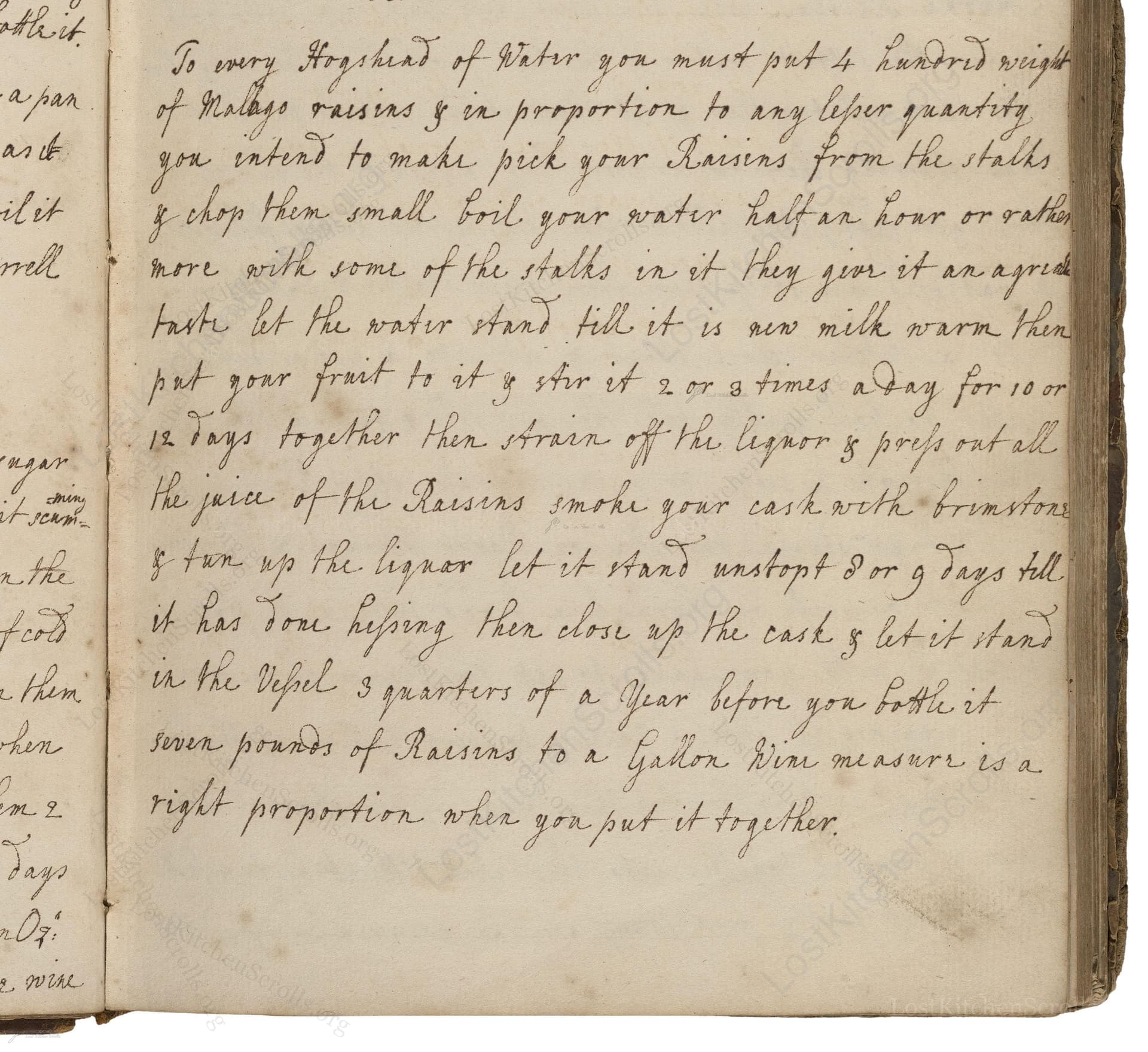Raisin Wine
From the treasured pages of Cookbook of Elizabeth Langley
Written by Elizabeth Langley

Raisin Wine
"To every Hogshead of Water you must put 4 hundred weight of Malaga raisins & in proportion to any lesser quantity you intend to make, pick your Raisins from the stalks & chop them small, boil your water half an hour or rather more with some of the stalks in it, they give it an agreable taste, let the water stand till it is new milk warm, then put your fruit to it & Stir it 2 or 3 times a day for 10 or 12 Days together, then strain off the liquor & press out all the juice of the Raisins, smoke your cask with brimstone & tun up the liquor, let it stand unstopt 8 or 9 Days till it has done hissing, then close up the cask & let it stand in the Vessel 3 quarters of a Year before you bottle it. seven pounds of Raisins to a Gallon Wine measure is a right proportion when you put it together."
Note on the Original Text
The recipe is written in a conversational, direct tone typical of 18th-century household manuscripts: measurements are given in familiar trade units (gallons, hundredweight), with proportions for both large and small batches. Words like 'hogshead' (a large cask) and 'tun up' (to fill the cask) reflect the everyday language of domestic brewing. Spelling and punctuation are idiosyncratic, and instructions assume a degree of intuition, common for experienced householders of the era.

Title
Cookbook of Elizabeth Langley (1757)
You can also click the book image above to peruse the original tome
Writer
Elizabeth Langley
Era
1757
Publisher
Unknown
Background
Step into the Georgian kitchen with Elizabeth Langley's 1757 culinary collection, where refined techniques and delightful recipes await those with a taste for historic gastronomy.
Kindly made available by
Folger Shakespeare Library
This recipe was penned by Elizabeth Langley in 1757, an era when sugar was still a luxury item in England and creative alternatives such as raisin wines were popular in middle-class households. The use of large quantities of Malaga raisins reflects both the influence of Mediterranean trade and the desire to recreate continental tastes. Homemade fruit wines offered a reliable (and sometimes safer) alternative to imported wines, and recipes like this one were widely exchanged among housewives intent on both thrift and elegance.

Back in the mid-18th century, making raisin wine required a sturdy copper or iron cauldron for boiling water, large wooden tubs or earthenware pots for steeping and fermenting, and strong wooden paddles for stirring. Straining was done with muslin or linen cloth, and pressing the raisins required either a simple press or vigorous squeezing by hand. Sterilizing with brimstone involved burning a piece of sulphur-impregnated cloth in the empty cask to kill off yeast and bacteria — a dramatic but effective method!
Prep Time
1 hr
Cook Time
30 mins
Servings
7
We've done our best to adapt this historical recipe for modern kitchens, but some details may still need refinement. We warmly welcome feedback from fellow cooks and culinary historians — your insights support the entire community!
Ingredients
- 7 lbs Malaga (or sultana) raisins per 1 imperial gallon water
- 1 imperial gallon water
- A handful of raisin stems (substitute: clean grape stems if unavailable)
- Brimstone (sulphur) for sterilizing, or modern sterilizer
Instructions
- To make Raisin Wine as described in Elizabeth Langley's 1757 recipe, you'll need to use good-quality Malaga (or substitute sultanas) raisins.
- For each 1 imperial gallon (4.5 liters) of water, use 7 lbs of raisins (about 3.2 kg).
- Remove the raisins from their stems, chop them into small pieces, and set aside some stems.
- Boil the water with a handful of the raisin stems for about 30 minutes to infuse a subtle tannic flavor.
- Allow the water to cool until it's warm to the touch (about 99°F), then add the chopped raisins.
- Stir the mixture 2-3 times daily for 10-12 days.
- Drain off the liquid and press out any remaining juice from the fruit pulp.
- Thoroughly clean your fermentation vessel and sterilize it — historically with brimstone (sulphur smoke), but today you can use a modern sanitizing agent.
- Pour in the strained liquid and leave the vessel loosely covered for about 8-9 days (until the fizzing subsides), then seal it tightly.
- Let the wine mature in the vessel for about 9 months before bottling.
Estimated Calories
150 per serving
Cooking Estimates
This recipe takes time to prepare and ferment. You'll spend about an hour getting the ingredients ready and boiling water. Actual cooking (boiling) takes 30 minutes. After prep, the mixture ferments for many days, but your hands-on work is just in the beginning. Each serving is around 150 calories, and the recipe makes about 7 servings.
As noted above, we have made our best effort to translate and adapt this historical recipe for modern kitchens, taking into account ingredients nowadays, cooking techniques, measurements, and so on. However, historical recipes often contain assumptions that require interpretation.
We'd love for anyone to help improve these adaptations. Community contributions are highly welcome. If you have suggestions, corrections, or cooking tips based on your experience with this recipe, please share them below.
Join the Discussion
Rate This Recipe
Dietary Preference
Main Ingredients

Den Bockfisch In Einer Fleisch Suppen Zu Kochen
This recipe hails from a German manuscript cookbook compiled in 1696, a time whe...

Die Grieß Nudlen Zumachen
This recipe comes from a rather mysterious manuscript cookbook, penned anonymous...

Ein Boudain
This recipe comes from an anonymous German-language manuscript cookbook from 169...

Ein Gesaltzen Citroni
This recipe, dating from 1696, comes from an extensive anonymous German cookbook...
Browse our complete collection of time-honored recipes



